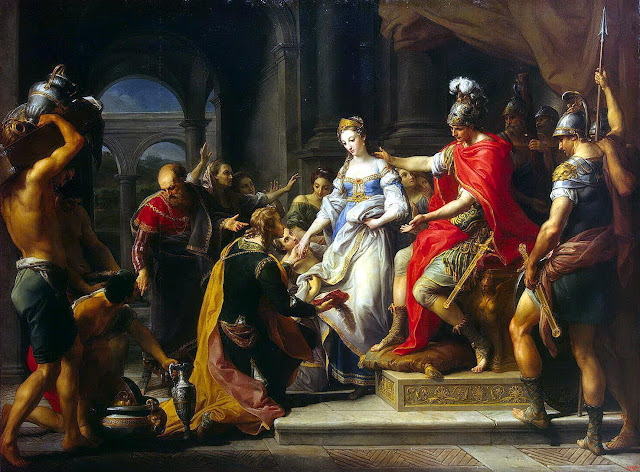 |
| Pompeo Batoni Continence of Scipio 1771 oil on canvas Hermitage, Saint Petersburg |
 |
| Pompeo Batoni Hercules at the Crossroads 1765 oil on canvas Hermitage, Saint Petersburg |
 |
| Giambattista Tiepolo Scipio Africanus Freeing Massiva ca. 1719-21 oil on canvas Walters Art Museum, Baltimore |
"There was a familiar repertoire of Greek and Roman stories which had been codified in the sixteenth and seventeenth centuries as suitable for the display of aristocratic virtues, and all subsequent artists drew heavily on it. But it is probable that such scenes may often have had far more precise meanings than are at present understood. Not only did many patrician families claim Roman descent, as has already been pointed out, but officials in the service of the state were used to hearing themselves compared to Roman heroes on the most trivial pretexts. . . . Unbridled dreams of power and grandeur on this scale, and the acute and genuine awareness of the Venetian nobles that (unlike their equivalents in France) they still represented the only real power in the State, kept history painting alive in Venice at a time when it was declining in expressive force and importance throughout Europe. 'There must be a great difference,' wrote Paulo Renier in 1772, 'between a minister who serves his Prince as a subject and one to whom God's special grace has granted the supreme boon of living in a free Republic and of being a small but essential part of the whole.' Some of the moral fervor of the French middle classes, which was to lead to a revival of history painting and culminate in the rhetoric of David, was here expressed by the aristocracy and found its champion in Tiepolo – though, of course, the results were wholly different in elegance, color and subject-matter. . . . Present-day taste finds the artist's bozzetti more appealing and, attracted by the general glamour of 'rococo' art, fails to grasp the grandeur and megalomania of Tiepolo's full-scale decorations. There is reason to believe that painters like Fragonard and some connoisseurs of the time may have made the same distinction. But admiration for Tiepolo's marvelous color and fantasy should not blind us to his moral commitment to the cause he was serving any more than it does in the case of Rubens."
– from Patrons and Painters: a study in the relations between Italian art and society in the Age of the Baroque by Francis Haskell (Yale University Press, 1980)
 |
| Sebastiano Ricci Battle of Lapiths and Centaurs ca. 1705 oil on canvas High Museum of Art, Atlanta |
 |
| Sebastiano Ricci Bacchus and Ariadne ca. 1700-1710 oil on canvas National Gallery, London |
 |
| Sebastiano Ricci Flora ca. 1712-16 oil on canvas Blanton Museum of Art, Austin, Texas |
 |
| Corrado Giaquinto Allegory of Peace and Justice 1753-54 oil on canvas Indianapolis Museum of Art |
 |
| Alessandro Magnasco Singing Birds before 1749 oil on canvas Phillips Collection, Washington DC |
"Alessandro Magnasco was born in Genoa to a painter father who died when he was three. He traveled to Milan in his teens and trained there with an obscure Venetian painter. In 1703 he was employed by the grand duke of Florence, where he remained for six years before returning to Milan. Early upon his return, Magnasco supplied figures for other painters' landscapes to make money. Subsequently he became very successful and remained until 1735. Magnasco began as a portrait painter but became known for religious works and scenes from the lives of monks, gypsies, and bandits, often in eerie, windswept landscapes that display the influence of Salvator Rosa. His paintings are easily identified by his free, open brushwork and the tiny, flame-like figures that seem almost to be strewn across the canvas. When he later returned to his native Genoa, he discovered that the Genoese found his style too raw and unfinished. Toward the end of his life, his output decreased and tremors in his hands gradually made it impossible for him to handle a brush. But, wrote his biographer, "He was always happy and even though decrepit with age, he seemed full of vigor and fire."
– biographical notes from the Getty Museum
 |
| Giovanni Battista Pittoni Death of King Candaulas ca. 1720-25 oil on canvas Hermitage, Saint Petersburg |
 |
| Francesco Solimena Emperor Charles VI and Gundacker Count Althann 1728 oil on canvas Kunsthistorisches Museum, Vienna |
 |
| Nicola Fiore Chinoiserie Wall Decoration for Drawing Room in the Palace of Caserta 1775 watercolor, gouache Cooper Hewitt Smithsonian Design Museum |
 |
| Michele Marieschi Grand Canal with Santa Maria della Salute ca. 1738-40 oil on canvas Museo Thyssen-Bornemisza, Madrid |
 |
| Pietro Longhi The Indiscreet Gentleman ca. 1740 oil on canvas National Museum of Western Art, Tokyo |
 |
| Marco Ricci Rehearsal of an opera ca. 1709 oil on canvas Yale Center for British Art |